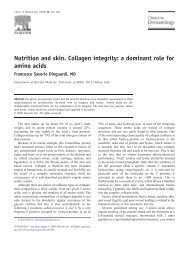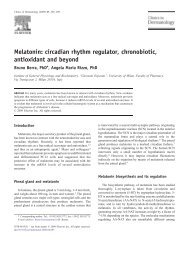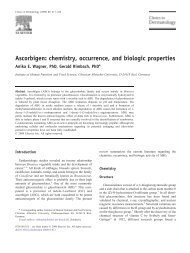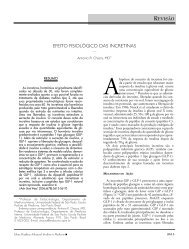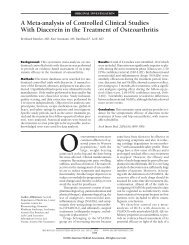Efficacy and safety of innovative cosmeceuticals
Efficacy and safety of innovative cosmeceuticals
Efficacy and safety of innovative cosmeceuticals
Create successful ePaper yourself
Turn your PDF publications into a flip-book with our unique Google optimized e-Paper software.
370 X.-H. Gao et al.<br />
applied agents, or water content <strong>of</strong> the stratum corneum.<br />
High amounts <strong>of</strong> cholesteryl sulfate, the intercellular cement,<br />
have been shown to inhibit desquamation. Cornified cell<br />
envelope, a structure synthesized at late stages <strong>of</strong> keratinocyte<br />
differentiation, is composed <strong>of</strong> structural proteins,<br />
including involucrin, loricrin, <strong>and</strong> the small proline-rich<br />
proteins. The stratum corneum possesses approximately 30%<br />
water, which is mainly associated with its elasticity. A<br />
healthy stratum corneum contains about 10% tightly held<br />
water. The tightly bound water is closely dependent on the<br />
presence <strong>of</strong> natural moisturizing factor. Natural moisturizing<br />
factor is composed <strong>of</strong> amino acids <strong>and</strong> their metabolites,<br />
which are byproducts formed from the breakdown <strong>of</strong><br />
filaggrin. Natural moisturizing factor is found exclusively<br />
inside the cells. 29 Perturbation <strong>of</strong> the aforementioned<br />
composites in stratum corneum might cause functional<br />
defect <strong>and</strong> clinical symptoms. Dry skin is one <strong>of</strong> the<br />
common problems due to defective stratum corneum. It is a<br />
condition featured by some subjective or objective denominators,<br />
including sensory characteristics with dry, uncomfortable,<br />
itchy, stinging, <strong>and</strong> tingling sensation; tactile<br />
characteristics with a rough, uneven, <strong>and</strong> s<strong>and</strong>like feeling;<br />
<strong>and</strong> visible characteristics with redness, lackluster surface,<br />
dry, white patches, flaky appearance, cracks, <strong>and</strong> even<br />
fissures. 30,31 In addition, several skin diseases are also<br />
featured by dry skin, including atopic dermatitis, ichthyosis,<br />
<strong>and</strong> the like. Moisturizers are agents designed to repair the<br />
damaged stratum corneum to make the stratum corneum<br />
s<strong>of</strong>ter <strong>and</strong> more pliant by increasing its hydration, resulting<br />
in smooth, more supple, <strong>and</strong> healthier looking skin. Moreover,<br />
moisturizers are also designed to act as adjuvant<br />
treatment option for some dermatologic diseases with feature<br />
<strong>of</strong> dry skin. From the view <strong>of</strong> <strong>safety</strong>, therapeutic moisturizers<br />
should be noncomedogenic, devoid <strong>of</strong> irritant ingredients,<br />
<strong>and</strong> compatible with many other therapeutic regimens.<br />
A formulation <strong>of</strong> lactic acid 12% neutralized with<br />
ammonium hydroxide <strong>and</strong> pramoxine hydrochloride 1%<br />
was tested on dry itchy skin for 7 days. Patients had<br />
statistically significant improvement in skin surface hydration<br />
by day 3, with further improvement by day 7, as<br />
compared with control. 32<br />
Pantothenic acid, a component <strong>of</strong> coenzyme A, serves as a<br />
c<strong>of</strong>actor for a variety <strong>of</strong> enzyme-catalyzed reactions that are<br />
important in the metabolism <strong>of</strong> carbohydrates, fatty acids,<br />
proteins, sterols, steroid hormones, <strong>and</strong> porphyrins. The<br />
topical use <strong>of</strong> dexpanthenol, the stable alcoholic analog <strong>of</strong><br />
pantothenic acid, improved stratum corneum hydration,<br />
reduced transepidermal water loss, <strong>and</strong> maintained skin<br />
s<strong>of</strong>tness <strong>and</strong> elasticity. 33<br />
A ceramide-dominant physiologic lipid-based emollient<br />
showed satisfactory results in the treatment <strong>of</strong> childhood<br />
atopic dermatitis, which is featured by dry skin. 34 A<br />
nicotinamide cream containing 2% nicotinamide was tested<br />
on atopic dry skin over 4 or 8 weeks; white petrolatum was<br />
used as control. The results showed that nicotinamide<br />
significantly decreased transepidermal water loss, but white<br />
petrolatum did not show any significant effect, though<br />
nicotinamide <strong>and</strong> white petrolatum increased stratum<br />
corneum hydration. 35 Another study showed that a niacinamide-containing<br />
facial moisturizer improved the stratum<br />
corneum barrier <strong>and</strong>, thus, provided a clinical benefit to<br />
subjects with rosacea. 36<br />
In xerotic skin, the proteolysis <strong>of</strong> desmosomes is reduced,<br />
leading to the accumulation <strong>of</strong> corneocytes on the surface <strong>of</strong><br />
the skin. Soap-induced xerosis could be ameliorated by the<br />
topical application <strong>of</strong> exogenous protease, such as bovine<br />
pancreatic chymotrypsin, papain, <strong>and</strong> a bacterial protease<br />
from Bacillus licheniformis. Alcalase <strong>and</strong> optimase, both<br />
broad specificity alkaline bacterial proteases, were the most<br />
efficient ones. Morphological <strong>and</strong> immunologic analysis <strong>of</strong><br />
bacterial enzyme-treated skin revealed that topically applied<br />
protease specifically induced the degradation <strong>of</strong> the desmosomes,<br />
thereby promoting desquamation. 37<br />
Antiwrinkle <strong>cosmeceuticals</strong><br />
Wrinkle is one <strong>of</strong> the key features <strong>of</strong> aging skin, including<br />
photoaging <strong>and</strong> chronological aging. 38 The exact pathogenesis<br />
<strong>of</strong> wrinkle is not fully understood yet. Changes in the<br />
dermis are most prominent in aged skin. Aged dermis has<br />
fragmented elastic fibers, decreased collagen, <strong>and</strong> disproportionate<br />
types I <strong>and</strong> III collagens. At the bottom <strong>of</strong> a wrinkle,<br />
type IV collagen is decreased. Glycosaminoglycans, especially<br />
hyaluronic acid, are decreased. Collagen damage is<br />
attributed to several types <strong>of</strong> collagen-degrading enzymes<br />
known as matrix metalloproteinases (MMPs). Metalloproteinases<br />
activation can result in production <strong>of</strong> collagenase,<br />
gelatinase, <strong>and</strong> stromelysin. The degradation <strong>of</strong> elastins<br />
might also be caused by MMP-2. 30<br />
Paeoniflorin (PF), partially purified from roots <strong>of</strong> Paeonia<br />
lactiflora, protected cells from DNA damage induced by<br />
UV-B irradiation in cultured normal human keratinocytes<br />
<strong>and</strong> hairless mouse keratinocytes. It was also revealed that<br />
0.5% PF-containing formulation reduced facial wrinkles<br />
during an 8-week clinical trial. These results suggest that<br />
the partially purified PF has potent antiaging <strong>and</strong> antiwrinkle<br />
activities, <strong>and</strong> should be a useful ingredient for<br />
these purposes. 39<br />
It was found that Morinda citrifolia fruit extract upregulated<br />
biosynthesis <strong>of</strong> type I collagen <strong>and</strong> glycosaminoglycans<br />
in primary cultures <strong>of</strong> normal human fibroblasts. 1,4-<br />
Dihydroxy-2-methoxy-7-methylanthraquinone, an active<br />
ingredient with a type I collagen–stimulating effect, was<br />
isolated <strong>and</strong> identified from M. citrifolia fruit. It was<br />
revealed that anthraquinone showed significantly increased<br />
elaboration <strong>of</strong> type I procollagen C-terminal peptide <strong>and</strong><br />
glycosaminoglycans, <strong>and</strong> reduced expression <strong>of</strong> the collagenase<br />
MMP-1 dose dependently in human dermal fibroblasts.<br />
Furthermore, a nanoemulsion containing anthraquinone<br />
predominantly increased the dermal type I procollagen in



